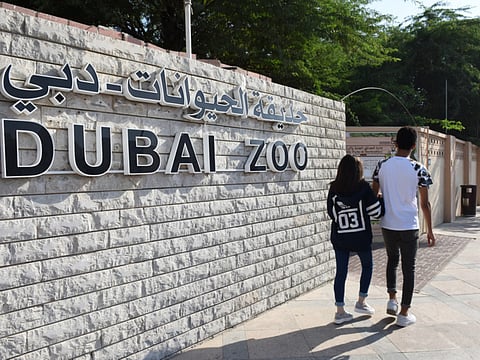50 years of taking people close to animal world
All animals in Dubai Zoo were either gifted by members of the public or confiscated by officials

Dubai: With just one week left to close its gates forever, the Dubai Zoo in Jumeirah has completed 50 years of taking UAE residents close to the animal world.
One of the first zoos in the Arabian Peninsula, the facility opened its doors to the public in May 1967.
It was Otto J. Bulart, an Austrian engineer, who built the zoo after he was given permission to start an animal corner by the then Ruler of Dubai late Shaikh Rashid Bin Saeed Al Maktoum, Dr Reza Khan, principal wildlife specialist at Dubai Safari and Dubai Municipality, told Gulf News on Saturday.
Dr Khan has served the zoo for 25 years, including 20 years as its head, till he moved to the Dubai Safari project in 2014.
“During the first couple of years, it housed only a few animals like two lions, some monkeys, some hoofed animals, and fishes brought from Fujairah by the son of Bulart.”
“The zoo then marked the end of the town. There was nothing beyond this building with wooden gates. There was no proper road to the zoo. People used to walk in the sand from the Jumeirah mosque area,” he recollected.
When Bulart was called in by late Shaikh Zayed Bin Sultan Al Nahyan to build the Al Ain Zoo, another Austrian couple took charge of the Dubai facility.
“Though it came under the Dubai Municipality in 1971, they still managed the zoo till another Austrian expert was brought in to head the section in 1984.”
Though a part of the zoo was redesigned and rebuilt by the time Dr Khan joined in 1989, he said, it was after that the zoo witnessed major renovations to reach its current stature.
At its peak time, the zoo housed 1,800 animals and birds, he said.
“All the animals that have come to this zoo have been either gifted by the members of the public or confiscated by the authorities. The only species we bought was caracal. We paid Dh2,000 to a man in Saudi Arabia to buy three of them.”
Receiving two gorillas, which were being smuggled through Dubai Airport, and two bears, which were left behind by circus companies, are memorable incidents for Dr Reza Khan.
Tactfully capturing the male gorilla Digit once it went out of the cage after the keeper left the back door open is an unforgettable experience for him.
“Had I not managed to hold him by neck for the vet to tranquillise, he would have gone out and created mayhem in Jumeirah,” he said, laughing.
In 1991, the municipality built the office building and three aviaries. It was then the first and last time the entry fee was hiked from Dh1 to Dh2.
The timing of the zoo was changed to keep it open for longer hours and during Ramadan and the weekly holiday was limited to one day.
“We had a team of about 18 keepers. They are the ones who built the majority of the building structures and animal cages in this zoo. Apart from taking care of the animals, they helped me to build the cages, make extra barriers and meshes to protect the animals and birds, the mosque and prayer room for ladies, air-conditioned rooms for the security and even the strong room of the zoo.”
All workers and officials who served the zoo will be honoured at a closing ceremony of Dubai Zoo on November 5. The current employees will be employed at Dubai Safari where most of the animals have already been moved to.
Without the hard work and constant efforts of the employees, it was difficult to protect the animals even from the visitors and the public outside, said Dr Khan.
“People would feed anything to the animals. They would try poking in with sticks and throw food packets and other things. The first giraffe we had died because it had been fed with all sorts of things by people from outside the gate and visitors. These things had caused a stone of 7.5kg in her stomach.”
Unruly visitors would jump the fences to take pictures with the animals. “Once, a Russian lady jumped over the fence when her friend was taking pictures. A leopard came and took a piece of flesh from her back. Another time, a father let his baby put her finger through the mesh and a wolf bit the tip of her finger.”
Pickpocketing was frequently reported by visitors. “Once somebody even stole a houbara bird.”
Children getting lost was also a frequent occurrence at the zoo. “Once I found a three-year-old boy walking alone. We couldn’t trace his parents inside the zoo. They had left without taking him. We had to inform the police. They alerted all the police stations in the UAE and traced the parents to Ras Al Khaimah,” Dr Khan recollected.
He said the zoo used to display the lost and found shoes of children alongside the zoo shop where it used to sell toys themed around animals.
“These are all part of the memories we cherished. People from all the emirates and Oman and other Gulf countries visited the zoo and had a lot of memories of interacting with the animals. Even now, we are receiving visitors,” said Dr Khan as he kept informing the visitors about the relocation of the animals to Dubai Safari as mentioned in the notice boards placed across the zoo.
Dubai Zoo is the first zoo in the world to breed Socotra cormorant, a threatened bird species, in 1991.
It is also the only zoo, other than purpose-built conservation centres, to have bred and released Greater flamingos back to nature.
It is the first Arabian zoo to have successfully bred Arabian chimpanzee and Herring gull.
Sign up for the Daily Briefing
Get the latest news and updates straight to your inbox


